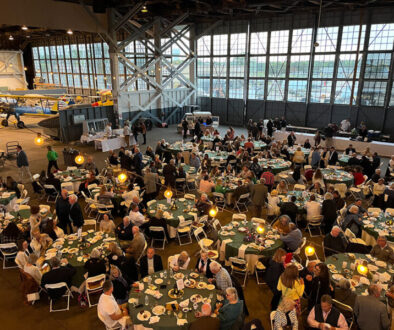The Transformation of 1069: The Demolition
Photographs by ELAINE STEVENSON & BERNIE HAAS

This article is Part 2 of an ongoing series.
If you haven’t read Part 1, click here to do so now!
Elaine Stevenson was a fan of Cape May since early childhood. She became a part-time Cape May County resident in 2011 when she bought a house in Cold Spring that she and her husband used as a vacation home. After he passed away, she began looking for a place to live in Cape May that could be a full-time home. In 2018, after months of searching, she found the LaMonica house on Michigan Avenue in Cape May City. With the full understanding that it would need substantial repairs, partial redesign, and structural alterations, she took ownership of it in March 2019.
One of the key goals of Elaine’s vision for the LaMonica house was to build a swimming pool. There wasn’t one in the back yard in part because it was too small for almost any recreational use. She knew that getting a pool installed on this property was something she would have to really work at in both the design and the budget for the project.

The zoning ordinances of the City of Cape May specify a certain percentage of a residential lot be allowed for drainage. By law, “coverage” by a building and its related impervious surfaces like sidewalks, steps, patio, and driveway must be limited to a specified proportion of the total lot. The LaMonica house was way over the allotted coverage; but it was built before the requirements were mandated. If left alone, the City would accept the conditions as “grandfathered in” at the time of the transfer of title. If any kind of structural changes were made afterwards, a new survey would be required showing that the current coverage limitations were met.
In order to have space for a pool, Elaine determined that the massive driveway would have to go. The garage which occupied several feet of the rear yard would have to be torn down and a new garage built to align with the front of the house. This move would result in changing the footprint, which would then disallow the existing coverage approval. Further, because the garage housed all the mechanicals—the electric panel, hot water heater, furnace, and blower—they would need to be moved and likely re-placed.
Elaine discussed her ideas for 1069 extensively with her builder. They agreed that hiring an architect was essential—not to prepare a totally new rendition of the property so much as to execute her own ideas for the house. She needed answers to questions that only a trained architect would have. And she needed to secure permissions from the City of Cape May.


Pam Fine was her architect of choice. Based in Cape May Court House, she was familiar with taking on local projects that required interpreting what consumers wanted and making them come to fruition. She could work with Elaine’s vision to create the drawings and, more importantly, make necessary structural changes and recommendations that would conform to code requirements.
Throughout the early spring, Pam took measurements and drew the existing house, remarking at one point that it had “great bones.” She came back with a preliminary set of floor plans and elevations in early June. Conversations led to repeated adjustments, and a month later she resubmitted a new set of drawings.
As the summer began, the builder’s workers started what could be described as “gentle demolition.” The elaborate carved oak panels that covered the walls and ceiling of the living room were removed, one nail at a time to preserve their surfaces. The marble railing was taken apart, and the high relief sculpture of the Last Supper that was imbedded in the dining room wall was extracted. Also in the dining room, more panels were similarly removed and carefully stored along with a chandelier.
The one item the men had not removed was the working fountain in the foyer. Research revealed that the fountain had originally been installed in the Fox Theater in Philadelphia in 1923. When the theater was demolished in 1980, 87,000 tons of marble and decorative pieces were sold off before the final clearing of the Market Street site. Somehow the fountain and over a thousand pounds of marble made it to Cape May to be installed in 1069 Michigan Avenue.
Elaine contacted several antique dealers to determine their interest in the artifacts that were dismantled. They were all curious but largely unresponsive. By chance, she found Ted Wiederseim of Weidersiem Associates, an auction house in Phoenixville, Pennsylvania. After carefully evaluating the trove, he offered her a check for everything that had been removed and agreed to have the fountain disassembled as well. It took three men all day to complete the removal and pack it up along with the panels, the high relief sculpture and several light fixtures.


By mid-summer, Elaine had an agreement of sale for her property in Cold Spring making her more determined to get the 1069 project moving forward. By then, Pam Fine had provided new floor plans that included creating a second-floor balcony shared by the two bedrooms. Sliding glass doors from each bedroom would give each of the guest rooms enhanced lighting and a unique place to relax in the sunshine.
Changing the stairway so that it didn’t bisect the first floor, and making the roofline into a true “hip” were necessary changes Elaine wanted done. These alterations added substantially to the cost of the framing and the roof. Upstairs, they not only added critical height to the interior rooms but also gave the upper level a more comfortable flow. On the first level, the stairs were relocated where there had been a closet, thus opening up the space for a wide great room.
A full set of sealed construction drawings and structural plans were submitted to the city; by late August, the zoning office officially rejected the plans, based on the coverage being slightly over the limit. To resolve the issue, the architect reduced the size of the garage and patio as well as the overhangs. Just after Labor Day, her new plans were submitted with a completed application for building permits. The application was approved a month later.

With the reality of having to install at least three steel beams and several engineered beams in the house, it was apparent that the estimate from the builder was no longer valid. He reviewed his subcontractors’ pricing and added the structural changes that the architect’s engineer had included. The real numbers from the subs came in and the builder adjusted his original price substantially. Elaine was startled enough to send out sealed bids to three other contractors to compare the pricing.
By this time, Elaine had finalized the sale of her Cold Spring property and needed to store furnishings in both a pair of rental sheds and in the cleared rooms of 1069. It wasn’t long before she then acquired a pod for storage offsite. Costs were mounting and time was passing.

Through the fall, Elaine evaluated contractor bids and made cost saving adjustments where she could. Her original contractor had one final chance before she offered the project to another who was more experienced with the kind of structural work that was required. Additionally, his bid was inclusive of everything that was required and more. He could start in January, almost exactly a full year after Elaine made her first offer on the house.
By the end of 2019, the original contractor had removed a great deal of plaster and woodwork to prepare for the construction of the interior walls. The more they exposed the house’s framing and the insides of the exterior walls, the more deterioration was revealed.
Gradual disintegration of a 60-year-old house is not unexpected; but much of what showed was alarming. In some areas flimsy insulation was the only barrier against outside air and moisture. Damage was particularly acute on both sides of the chimney, from the roof on down the inside of the living room wall. Water intrusion from one of the bathtubs caused the subflooring to fail completely after the tiles were removed. Beneath parts of the marble flooring in the dining room weak rotted subfloors contributed to an uneven surface. Every new reveal meant more time and more money. And everywhere there was the penetrating smell of mold.
Having secured permits, demolition could begin in earnest. The new contractor began by removing more plaster and entire walls, exposing studs throughout the house. The debris, mainly plaster and marble, filled one dumpster after another. He stowed metal and wiring in different barrels for recycling and measured carefully what would be demolished and what would remain. He made careful cuts in the floors, roof and walls and he severed wiring and pipes to carefully prepare for the excavator.



On January 28, a heavy equipment operator with a John Deere midi excavator arrived to tear down the attached garage. It took much of the day before he moved the machine to the back of the house. On his second day on the site, he clawed at the enclosed porch wall, white bricks falling scores at a time until it was down, and several dumpsters later, he took out the flagstone patio and the remainder of the Tennessee Marble retaining walls. On the final day he cleared the side and rear yards. When he finished, nothing was demolished that wasn’t supposed to be; what remained was a much smaller, and sadder, house. But not for long! At the end of January, the demolition was completed.
A schedule for concluding the entire project was set, though all agreed that it was a “best guess.” The builder determined he could finish his work on 1069 Michigan by June.
Three weeks into February, the United States Center for Disease Control was warning that there would likely be a deadly outbreak of COVID-19 throughout the country by spring. ■



